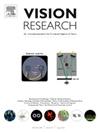The effect of stimulus size on binocular luster and its implications for the interocular conflict model
IF 1.4
4区 心理学
Q4 NEUROSCIENCES
引用次数: 0
Abstract
Using a series of dichoptic center-ring-surround stimuli in a psychophysical experiment, we examined how the phenomenon of binocular luster is affected by the size of the central target area. Generally, we found that the lustrous sensation continuously decreases with increasing patch size. However, this effect also depends on further stimulus features such as the interocular contrast polarity pairings and the width of the ring element. To account for these complex influences on the magnitude of the lustrous response, significant extensions had to be made to our interocular conflict model. We present two improved versions of our model, a summation and an averaging model, which differ in the way the local conflict values are spatially integrated. Both versions have a very high predictive power. At least for the summation model, we show that the modifications are in good agreement with physiological processes. In particular, we provide evidence that the influence of stimulus size on the lustrous effect can be explained by the combination of two mechanisms: An increasing receptive field size of contrast detector cells and at the same time a decrease of the local density of these cells with increasing retinal eccentricity.
刺激大小对双眼光泽的影响及其对眼间冲突模型的启示
在心理物理实验中,我们使用了一系列的中心-环-环双视刺激,研究了中心靶区的大小对双眼光泽现象的影响。一般来说,我们发现随着斑块尺寸的增加,光泽感觉不断降低。然而,这种效果还取决于进一步的刺激特征,如眼间对比极性配对和环元素的宽度。为了解释这些对发光反应强度的复杂影响,必须对我们的眼间冲突模型进行重大扩展。我们提出了两个改进版本的模型,即求和模型和平均模型,它们在局部冲突值的空间集成方式上有所不同。两个版本都有很高的预测能力。至少对于总和模型,我们表明这些修饰与生理过程很好地一致。特别是,我们提供的证据表明,刺激大小对发光效应的影响可以通过两种机制的结合来解释:对比度检测器细胞的感受野大小增加,同时这些细胞的局部密度随着视网膜偏心度的增加而减少。
本文章由计算机程序翻译,如有差异,请以英文原文为准。
求助全文
约1分钟内获得全文
求助全文
来源期刊

Vision Research
医学-神经科学
CiteScore
3.70
自引率
16.70%
发文量
111
审稿时长
66 days
期刊介绍:
Vision Research is a journal devoted to the functional aspects of human, vertebrate and invertebrate vision and publishes experimental and observational studies, reviews, and theoretical and computational analyses. Vision Research also publishes clinical studies relevant to normal visual function and basic research relevant to visual dysfunction or its clinical investigation. Functional aspects of vision is interpreted broadly, ranging from molecular and cellular function to perception and behavior. Detailed descriptions are encouraged but enough introductory background should be included for non-specialists. Theoretical and computational papers should give a sense of order to the facts or point to new verifiable observations. Papers dealing with questions in the history of vision science should stress the development of ideas in the field.
 求助内容:
求助内容: 应助结果提醒方式:
应助结果提醒方式:


